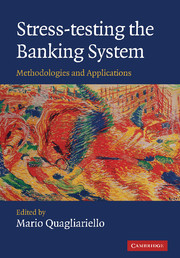Book contents
- Frontmatter
- Contents
- List of figures
- List of tables
- List of boxes
- List of contributors
- Foreword
- Acknowledgements
- Introduction
- Part I Fundamentals
- Part II Applications
- 8 Stress-testing credit risk: the Italian experience
- 9 Stress-testing US banks using economic-value-of-equity (EVE) models
- 10 A framework for integrating different risks: the interaction between credit and interest rate risk
- 11 Stress-testing linkages between banks in the Netherlands
- 12 An integrated approach to stress-testing: the Austrian Systemic Risk Monitor (SRM)
- 13 From macro to micro: the French experience on credit risk stress-testing
- 14 Stress-testing in the EU new member states
- 15 Cross-border macro stress-testing: progress and future challenges for the EU
- 16 Stress-testing at the IMF
- Conclusions
- Index
- References
11 - Stress-testing linkages between banks in the Netherlands
from Part II - Applications
Published online by Cambridge University Press: 18 December 2009
- Frontmatter
- Contents
- List of figures
- List of tables
- List of boxes
- List of contributors
- Foreword
- Acknowledgements
- Introduction
- Part I Fundamentals
- Part II Applications
- 8 Stress-testing credit risk: the Italian experience
- 9 Stress-testing US banks using economic-value-of-equity (EVE) models
- 10 A framework for integrating different risks: the interaction between credit and interest rate risk
- 11 Stress-testing linkages between banks in the Netherlands
- 12 An integrated approach to stress-testing: the Austrian Systemic Risk Monitor (SRM)
- 13 From macro to micro: the French experience on credit risk stress-testing
- 14 Stress-testing in the EU new member states
- 15 Cross-border macro stress-testing: progress and future challenges for the EU
- 16 Stress-testing at the IMF
- Conclusions
- Index
- References
Summary
Introduction
Assessment of the stability of the financial sector is well established in the Netherlands. Spurred by the International Monetary Fund's (IMF) Financial Sector Assessment Program (FSAP) in 2004 and by increased attention for financial stability, as witnessed by the creation of a separate financial stability division at the central bank (De Nederlandsche Bank, DNB), many issues have been studied.
An example is the analysis conducted and reported in the bi-annual Overview of Financial Stability in the Netherlands, highlighting inter alia operational problems in payment systems and the effect of (failing) credit risk transfer on the soundness of financial firms. Sometimes such analyses come eerily close to reality, as was the case with the securitisation scenario computed in mid-2007 (DNB, 2008). In this scenario banks were asked to compute the cost of taking their most recent securitisation back on the book. Liquidity effects found in this scenario were limited because of the short time horizon considered. In reality, in the late summer of 2007, the vulnerability of banks with the so-called originate-to-distribute model, in which banks securitise issued loans and sell them to interested investors via special legal entities, emerged prominently. Rising sub-prime mortgage default rates and growing doubts about the nature and value of the assets of special legal entities led to widespread downgrading of structured credit products containing such loans. This in turn caused the market financing of these entities to evaporate, generating uncertainty about possible draw downs of credit lines at sponsor banks.
- Type
- Chapter
- Information
- Stress-testing the Banking SystemMethodologies and Applications, pp. 184 - 201Publisher: Cambridge University PressPrint publication year: 2009



